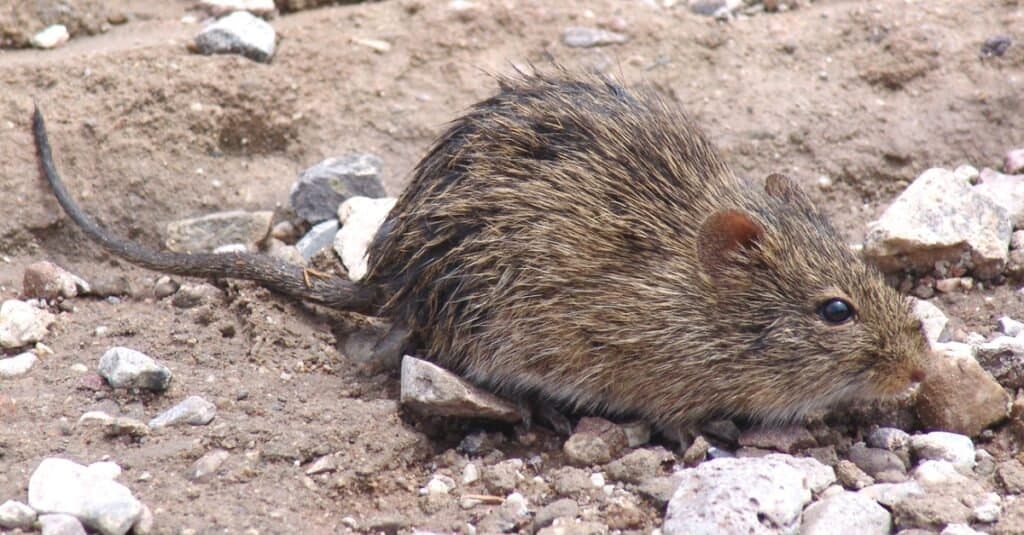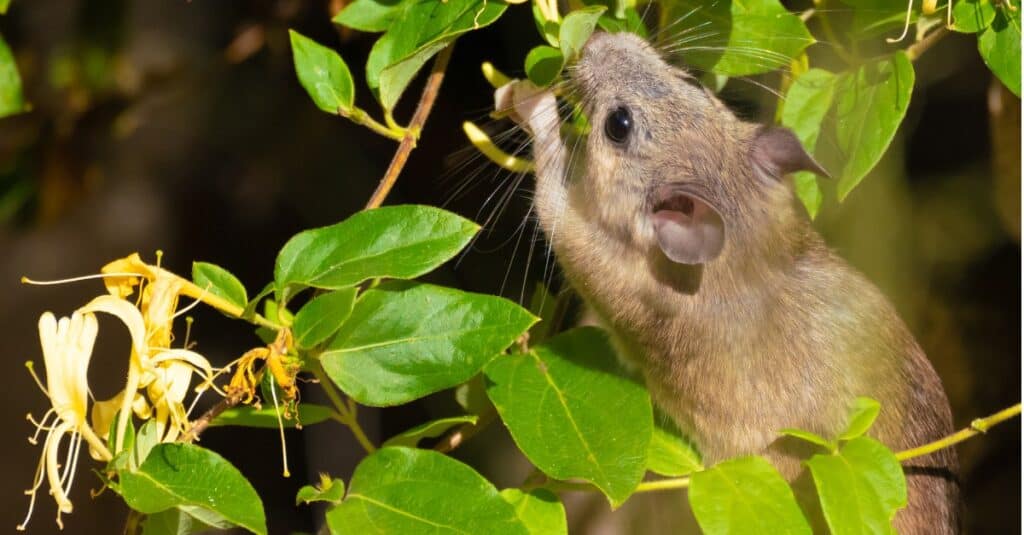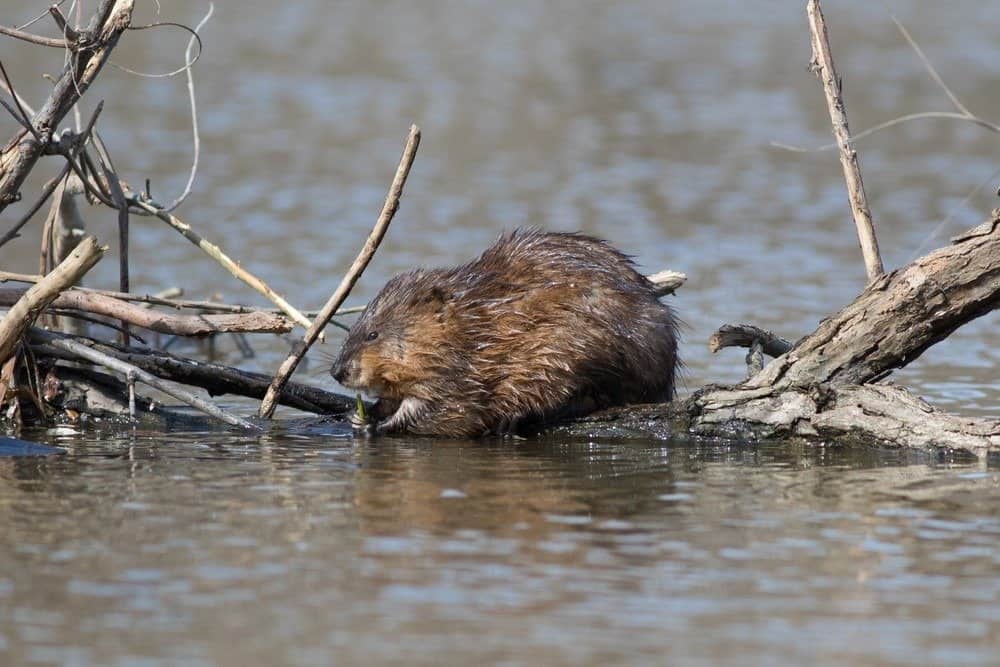The common rat is one of the most important creatures in the world in both good and bad ways. They’ve been used as research animals allowing science to advance, but they’ve also been a key vector for deadly diseases. People have such strong feelings about rats that they dislike other rodents, especially those that share their name, like the muskrat. Instead of writing off this rodent, let’s instead take a look at how they’re unique. We will consider the differences between the muskrat vs rat and show how to tell these rodents apart.
Comparing a Muskrat and a Rat

| Muskrat | Rat | |
| Size | Weight: 1.5lbs-4lbs Height: 4in-5in Length: 16in-25in | Weight: 0.4lbs-2lbs Height: 2.4in-3.5in Length: 13in-18in from nose to tail, with the longest being 20 inches of body length |
| Tail | -Has a thicker and a longer tail than rats – Flattened on the sides and not used to propel themselves while swimming – Often confused for beavers, but their tails aren’t as wide | – Thin, cylindrical, and long tail |
| Preferred Habitat | Burrows near lakes, ponds, and wetlands | Burrow underground and close to human settlements for easy access to food |
| Territorial Defenses | -Very territorial and will excrete a nasty musk from which they get their names to protect themselves. – Will bite and claw other animals, and they can attack people to some extent | -Territorial creatures that won’t welcome outsiders into colonies with ease. – Attack with biting – They will attack members of other colonies that stray into their area |
| Fur and Color | – Thick, two-layered fur to help keep them warm while swimming – Dark brown to a light grayish-brown with a slightly lighter color on their stomach | – One layer of fur – Dark brown, gray, and black or will be grayish-brown with a light underside |
| Active time | Mostly nocturnal but will be most active between afternoon and dusk. | Completely nocturnal |
The Key Differences Between a Muskrat vs Rat

Rats differ from muskrats in many ways, such as their size and tails.
©iStock.com/rtrible
The biggest differences between a muskrat vs rat are their size, habitat, and tails. Muskrats are larger than most common rats, both in terms of their bodies and tails.
Although rats prefer to live in burrows underground near human settlements, muskrats are semiaquatic rodents that prefer to live in burrows near lakes, ponds, and wetlands.
Muskrats’ tails are both thicker and longer than the tails of common rats. Also, they are shaped differently, with flat sides instead of the cylindrical shape that rats possess. These are the most significant differences between the animals, and they are the best way to tell them apart from one another.
Muskrat vs Rat: Size

Rats are smaller than muskrats
©iStock.com/Moment of Perception Photography
Muskrats are larger than common rats in every dimension. Muskrats regularly reach 4lbs or more in weight, 5 inches in height, and lengths of over 2ft. Rats are usually about 2lbs in weight, 3.5 inches in height, and will measure about 18 inches long in the vast majority of cases.
Although both animals are rodents, it’s very difficult to confuse one for the other. Muskrats look more like beavers than rats, and they’re more closely related to them as well.
Muskrat vs Rat: Tail
Muskrat tails are longer, thicker, and have a different shape compared to rat tails. In fact, muskrats are often confused for their cousins, the beaver, because of how large their tails can grow.
A rat’s tail is long relative to its body and has a cylindrical, stringy shape. Muskrats’ tails are even longer, much thicker, and have two flat sides to them. That tail shape is very unique and makes it simple to differentiate a muskrat from just about any other creature.
The muskrat’s tail doesn’t help them move faster in water like a crocodile’s tail though. Instead, it’s used as a rudder to help them swim straight. Also, the tail drags when the muskrat is on land, so their tracks are easy to spot.
Muskrat vs Rat: Preferred Habitat

Muskrats are semiaquatic rodents.
©William Levesque/Shutterstock.com
Rats prefer to burrow underground and establish colonies near human settlements. Muskrats are semiaquatic animals that prefer to create their burrows near bodies of water like lakes, ponds, and other wetlands.
Muskrats spend significant amounts of time in the water, and they’re capable of going underwater for up to 15 minutes or more! They’re great swimmers, even better than rats. They also have webbed back feet, allowing them to reach speeds of 3 mph in the water.
You won’t see muskrats in the middle of a city at night, but you will see rats at that time and location.
Muskrat vs Rat: Territorial Defenses
Muskrats are territorial creatures that live in colonies, and they will defend their burrows with a smelly musk that they produce. Rats are less territorial creatures in the sense that they will not seek a fight with a larger predator, but they do not like outsider rats coming into their colonies, especially males.
Rats do not have any chemical aids to help them combat their enemies, though. They will bite other rats or flee from larger creatures. Muskrats might attack larger creatures, and they will even attack humans that corner them.
Muskrat vs Rat: Fur and Color
Muskrats are usually a dark brown or grayish-brown color with a slightly lighter underbelly. Two of the most common rat colorations include black, gray, and dark brown or grayish-brown with a light underbelly. Although the grayish-brown rats can look like muskrats, they have far lighter underbellies than a muskrat.
Their fur coats are different, too. Muskrats have two layers of fur that help keep them warm when they’re swimming, but rats only have a single, thinner layer of fur on their bodies.
Muskrat vs Rat: Active Time

Muskrats are active in the latter part of the day, but rats are only active at night.
©Steve Gillick/Shutterstock.com
Muskrats and rats are both nocturnal creatures by nature, but muskrats’ most active times include between afternoon and dusk. Generally speaking, if one sees a large rodent in the middle of the day near water, the chances are higher that it’s a muskrat rather than a common rat.
Both rats and muskrats are interesting rodents that are both necessary parts of the ecosystem and capable of wreaking havoc upon it. The ease with which they reproduce and the amount of food they eat are stunning. Nevertheless, they are distinct creatures that are easy to tell apart based on their size, habitat, tails, and other behaviors.
The photo featured at the top of this post is © Blende8/Shutterstock.com
Thank you for reading! Have some feedback for us? Contact the AZ Animals editorial team.






